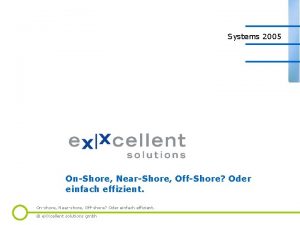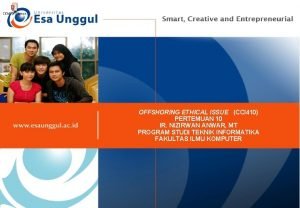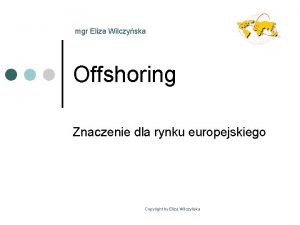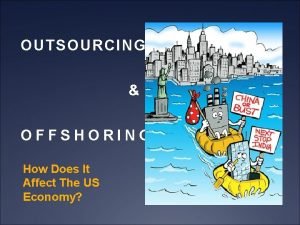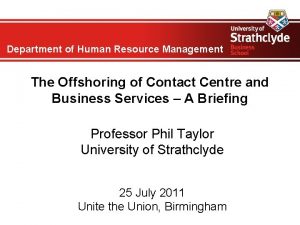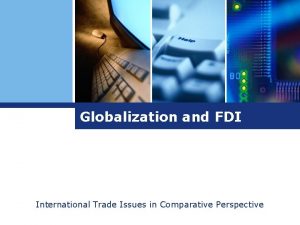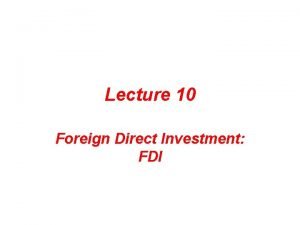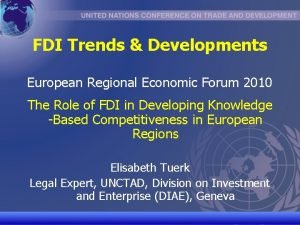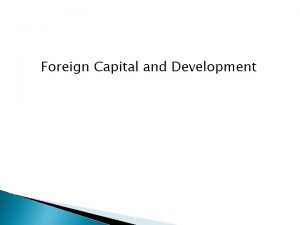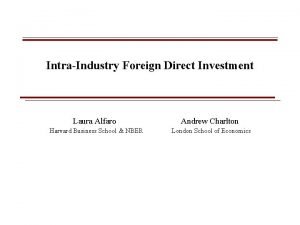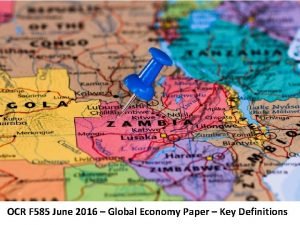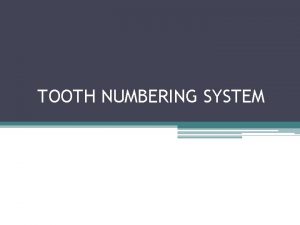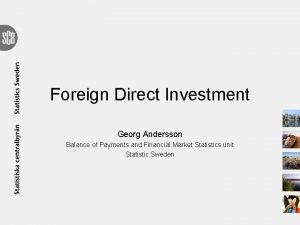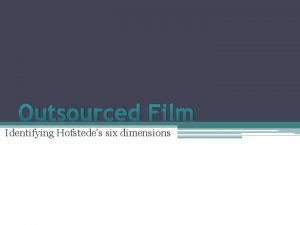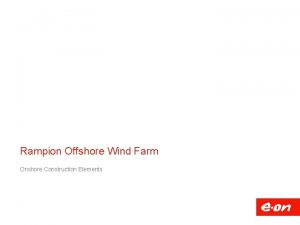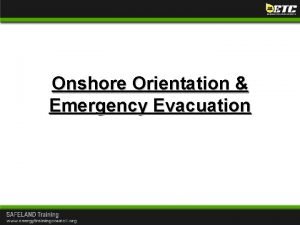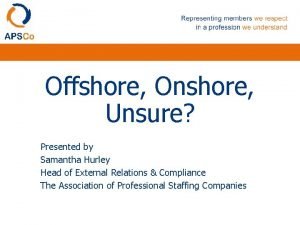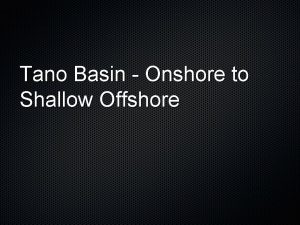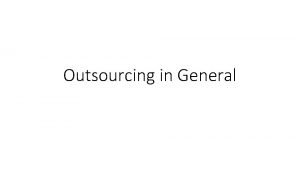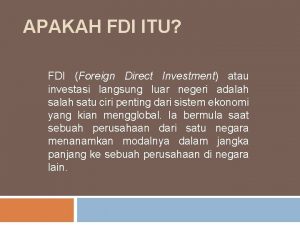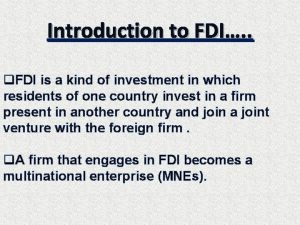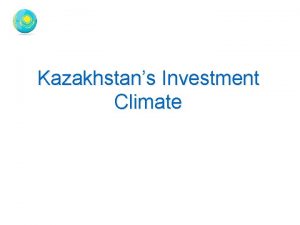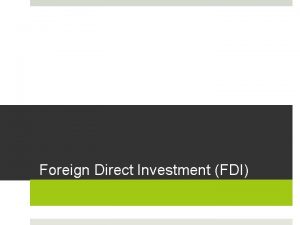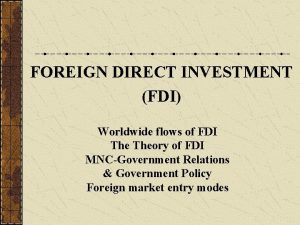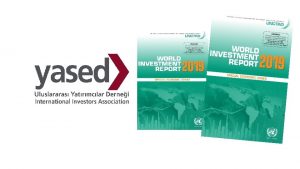Outsourced Offshoring FDI Offshore Outsourcing Onshore Outsourcing ExternalDomestic





























- Slides: 29





Outsourced Offshoring와 FDI의 관계 Offshore Outsourcing Onshore Outsourcing (External-Domestic Supply) (External cross-border Supply) Insourced Control Internal Domestic Supply Internal Offshoring (Internal cross-border Supply) International National Location

주요국의 기타사업서비스, 컴퓨터 및 정보 서비스 수출증가율(1995 -2002) 자료: OECD, "International Sourcing and Offshoring", DSTI/ICCP/IE(2004)9


EIU's Business Environment Rankings 2006 Total score 2002 -06 Rank 2002 -06 Total score 2007 -11 Rank 2007 -11 Change in total score Change in rank Singapore 8. 66 3 8. 74 4 0. 08 -1 Hong. Kong 8. 55 7 8. 61 8 0. 06 -1 Taiwan 7. 62 21 8. 05 19 0. 43 2 South Korea 7. 10 25 7. 56 24 0. 45 1 Malaysia 7. 29 23 7. 37 32 0. 08 -9 Thailand 6. 71 34 6. 87 42 0. 16 -8 Philippines 5. 94 48 6. 36 52 0. 42 -4 China 5. 59 57 6. 36 53 0. 97 6 Indonesia 5. 37 60 6. 34 54 0. 97 6 India 5. 34 61 6. 12 58 0. 78 3 Vietnam 4. 78 70 5. 75 64 0. 97 6 Sources: EIU, Business Environment Ranking, 2006

EIU's Offshoring Environment Rankings 2005 Proximity Political environment & security India 4. 37 7. 20 8. 40 6. 00 6. 50 9. 69 7. 78 7. 33 4. 60 7. 76 1 China 8. 07 6. 00 9. 20 5. 25 5. 50 9. 70 6. 46 5. 33 5. 20 7. 34 2 Singapore 5. 90 8. 40 8. 80 9. 50 8. 50 6. 23 6. 92 8. 00 7. 40 7. 25 4 Hong Kong 7. 24 6. 80 9. 60 8. 50 7. 33 5. 65 8. 67 8. 20 7. 19 7 Philippines 7. 17 6. 00 8. 40 5. 75 7. 50 9. 80 5. 18 8. 00 5. 00 7. 17 9 Thailand 5. 59 7. 60 9. 60 6. 25 7. 50 9. 65 4. 87 7. 33 6. 00 7. 16 10 Malaysia 5. 92 7. 60 9. 20 7. 00 8. 52 5. 65 7. 33 5. 40 7. 13 11 Taiwan 8. 04 7. 60 9. 60 8. 25 8. 00 6. 80 5. 79 8. 00 7. 80 7. 05 16 S. Korea 9. 01 7. 60 9. 60 7. 75 7. 00 5. 58 6. 09 7. 33 8. 00 6. 70 25 (17) (24) (6) (27) (24) (41) (15) (19) (5) Vietnam 6. 51 5. 60 6. 40 5. 00 6. 00 9. 75 4. 74 7. 33 3. 00 6. 59 30 Indonesia 4. 43 4. 00 8. 80 4. 50 5. 50 9. 91 4. 89 6. 00 4. 20 6. 54 32 average 7. 09 7. 12 8. 49 7. 13 6. 60 7. 13 5. 40 6. 94 5. 99 6. 58 Macroeconomic stabillity Regulatory environment Tax regime Sources: EIU, Offshoring Environment Rankings, 2005 Labour costs Labour skills & availability Labour regulation Infrastructure Total score Rank

Weightings for the offshoring rankings Labour costs 0. 3 Labour skills 0. 3 Labour regulation 0. 1 Proximity 0. 05 Political and security risk 0. 05 Macroeconomic stability 0. 05 Regulatory environment 0. 05 Tax regime 0. 05 Infrastructure 0. 05 Sources: EIU, Offshoring Environment Rankings, 2005

Indicators in the offshoring rankings model Sources: EIU, Offshoring Environment Rankings, 2005

Indicators of the Offshoring Rankings Ⅰ Sources: EIU, Offshoring Environment Rankings, 2005

Indicators of the Offshoring Rankings Ⅱ Sources: EIU, Offshoring Environment Rankings, 2005

Indicators of the Offshoring Rankings Ⅲ Sources: EIU, Offshoring Environment Rankings, 2005

Indicators of the Offshoring Rankings Ⅳ Sources: EIU, Offshoring Environment Rankings, 2005

Indicators of the Offshoring Rankings Ⅴ Sources: EIU, Offshoring Environment Rankings, 2005

Indicators of the Offshoring Rankings Ⅵ Sources: EIU, Offshoring Environment Rankings, 2005

Indicators of the Offshoring Rankings Ⅶ Sources: EIU, Offshoring Environment Rankings, 2005

Indicators of the Offshoring Rankings Ⅷ Sources: EIU, Offshoring Environment Rankings, 2005

Indicators of the Offshoring Rankings Ⅸ Sources: EIU, Offshoring Environment Rankings, 2005

Reasons for Choosing Offshoring Locations: Competition for Talents? Source: Arie Y. Lewin, From Offshoring to Globalization of Human Capital? Findings from Offshoring Research Network (ORN) Project, KIEP LES Seminar on Nov. 7, 2006.


Labor Skill 관련 지표 추정 Indicators of Labor Skills India Singapore China Korea 1. Quality of maths and science education 1 1 2. English language skills 1 1 2 3 1. 5 1 2 1 2 Sum 4. 5 5. 0 6. 0 7. 0 EIU Measure 7. 78 6. 92 6. 46 6. 09 3. Technical skills of the workforce 4. Labour force • The measure of English language skills reflects a combination of Toefl scores (Toefl is a test of English as a foreign language) and qualitative assessment of the availability of English, related to population size. • For example, average English ability is relatively low in India but because of the size of the country’s population it still offers a massive pool of English-speakers. • The education indicators are drawn from the World Economic Forum’s Global Competitiveness Report 2003 -04 and the Economist Intelligence Unit’s e-readiness model






 Onshore offshore nearshore
Onshore offshore nearshore Outsourced offshore testing
Outsourced offshore testing Offshoring eastern europe
Offshoring eastern europe Cci code of ethics
Cci code of ethics Dr wilczyńska stalowa wola
Dr wilczyńska stalowa wola Arguments against offshoring
Arguments against offshoring What is offshoring in hrm
What is offshoring in hrm Fdi
Fdi Greenfield investment
Greenfield investment Role of fdi
Role of fdi Fdi
Fdi Eclectic theory
Eclectic theory Foreign investment in finland
Foreign investment in finland Vertical fdi examples
Vertical fdi examples Fdi in international business
Fdi in international business Fdi meaning
Fdi meaning Non-equity strategic alliance pros and cons
Non-equity strategic alliance pros and cons Tratado kellog alfaro
Tratado kellog alfaro Fdi tutor2u
Fdi tutor2u Eclectic theory
Eclectic theory Tooth numbering system types
Tooth numbering system types Dr manisha mishra
Dr manisha mishra Fdi meaning
Fdi meaning Outsourced movie hofstede
Outsourced movie hofstede Film outsourced
Film outsourced Microalgae outsourced production
Microalgae outsourced production Outsourced movie analysis
Outsourced movie analysis Outsource storyboard
Outsource storyboard Gupta outsourced
Gupta outsourced Energy management outsourcing
Energy management outsourcing
